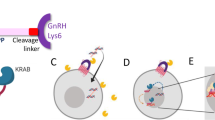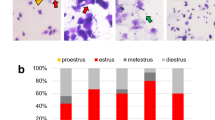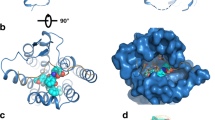Abstract
Human reproduction is controlled by the hypothalamic–pituitary–gonadal axis laid down early in fetal development. Luteinizing hormone releasing hormone (LHRH), also termed gonadotropin releasing hormone (GnRH), is a decapeptide1,2 and is a key molecule in this control circuit. It is produced by hypothalamic neurones, secreted in a pulsatile manner into the capillary plexus of the median eminence and effects the release of luteinizing hormone and follicle stimulating hormone from gonadotropic cells in the anterior pituitary3. The peptide may have further functions, including behavioural ones4, as LHRH or LHRH-like immunoreactivity has been found in gonadal tissue5,6, placenta7,8 and the central nervous system9,10, and exogenously administered LHRH is shown to affect behaviour11,12. To investigate the biosynthesis of LHRH, we have now isolated cloned genomic and cDNA sequences encoding the precursor form of LHRH, the existence of which had been suggested from Chromatographic studies of hypothalamic8,13 and placental8 extracts. These DNA sequences code for a protein of 92 amino acids in which the LHRH decapeptide is preceded by a signal peptide of 23 amino acids and followed by a Gly-Lys-Arg sequence, as expected for enzymatic cleavage of the decapeptide from its precursor14–16 and amidation17 of the carboxy-terminal of LHRH.
This is a preview of subscription content, access via your institution
Access options
Subscribe to this journal
Receive 51 print issues and online access
$199.00 per year
only $3.90 per issue
Buy this article
- Purchase on SpringerLink
- Instant access to full article PDF
Prices may be subject to local taxes which are calculated during checkout
Similar content being viewed by others
References
Matsuo, H. et al. Biochem. biophys. Res. Commun. 43, 1334–1339 (1971).
Burgus, R. et al. Proc. natn. Acad. Sci. U.S.A. 69, 278–282 (1972).
Schally, A. V. et al. Biochem. biophys. Res. Commun. 43, 393–401 (1971).
Moss, R. L. Fedn Proc. 36, 1978–1983 (1977).
Ying, S. Y., Ling, N., Bohlen, P. & Guillemin, R. Endocrinology 108, 1206 (1982).
Bhasin, S., Heber, D., Peterson, M. & Swerdloff, R. Endocrinology 112, 1144–1145 (1983).
Khodr, G. S. & Siler-Khodr, T. M. Science 207, 315–317 (1980).
Gautron, J. P., Pattou, E. & Kordon, C. Molec. cell. Endocr. 24, 1–16 (1981).
Silverman, A. J. & Krey, L. C. Brain Res. 157, 233–246 (1976).
Samson, W. K. et al. Neuroendocrinology 31, 66–72 (1980).
Moss, R. L. & McCann, S. M. Science 181, 177–179 (1973).
Pfaff, D. W. Science 182, 1148–1150 (1973).
Millar, R. P., Ashnelt, C. & Rossier, G. Biochem. biophys. Res. Commun. 74, 720–726 (1977).
Steiner, D. F. et al. Ann. N. Y. Acad. Sci. 343, 1–16 (1980).
Nakanishi, S. et al. Nature 278, 423–427 (1979).
Gubler, U. et al. Nature 295, 206–208 (1982).
Bradbury, A. F., Finnie, M. D. A. & Smyth, D. G. Nature 298, 686–688 (1982).
Anderson, S. & Kingston, B. Proc. natn. Acad. Sci. U.S.A. 80, 6838–6842 (1983).
Jaye, M. et al. Nucleic Acids Res. 11, 2325–2335 (1983).
Ullrich, A. et al. EMBO J. 3, 361–364 (1984).
Messing, J., Crea, R. & Seeburg, P. H. Nucleic Acids Res. 9, 309–321 (1981).
Lawn, R. M. et al. Cell 15, 1157–1163 (1978).
Huynh, T., Young, R. & Davis, R. in Practical Approaches in Biochemistry (ed. Grover, D.) (IRL Press, Oxford, in the press).
Tan, L. & Rousseau, P. Biochem. biophys. Res. Commun. 109, 1061–1071 (1982).
Orihawa, S. et al. Nature 306, 611–614 (1983).
Young, R. A., Hagenbuchle, O. & Schibler, U. Cell 23, 451–458 (1981).
Proudfoot, N. J. & Brownlee, G. G. Nature 263, 211–214 (1976).
Breathnach, R. et al. Proc. natn. Acad. Sci. U.S.A. 75, 4853–4857 (1978).
Lehrach, H., Diamond, D., Wozney, J. M. & Boedtker, H. Biochemistry 16, 4743–4751 (1977).
Douglass, J., Civelli, O. & Herbert, E. A. Rev. Biochem. 53, 665–750 (1984).
Kozak, M. Nature 308, 241–246 (1984).
Kozak, M. Nucleic Acids Res. 9, 5233–5252 (1981).
Perlman, D. & Halvorson, H. O. J. molec. Biol. 167, 391–409 (1983).
Land, H., Schutz, G., Schmale, H. & Richter, D. Nature 295, 299–303 (1982).
Shen, L. P., Pictet, R. L. & Rutter, W. J. Proc. natn. Acad. Sci. U.S.A. 79, 4575–4579 (1982).
Furutani, Y. et al. Nature 301, 539–540 (1983).
Gubler, U. et al. Proc. natn. Acad. Sci. U.S.A. 80, 4311–4314 (1983).
Chauvet, M. T., Chauvet, J. & Acher, R. Eur. J. Biochem. 69, 475–485 (1976).
McCann, S. M. Neuroendocrinology 31, 355–363 (1980).
Southern, E. J. molec. Biol. 98, 503–517 (1975).
Curtis, A. & Fink, G. Endocrinology 112, 390–392 (1983).
Amara, S. G. et al. Nature 248, 240–244 (1982).
Kakidani, H. et al. Nature 298, 245–249 (1982).
Smyth, D. G., Stein, W. H. & Moore, S. J. biol. Chem. 238, 227–234 (1963).
Crea, R. & Horn, T. Nucleic Acids Res. 8, 2331–2348 (1980).
Sherwood, N. et al. Proc. natn. Acad. Sci. U.S.A. 80, 2794–2798 (1983).
Sanger, F., Nicklen, S. & Coulson, A. R. Proc. natn. Acad. Sci. U.S.A. 74, 5463–5467 (1977).
Messing, J. & Vieira, J. Gene 19, 269–276 (1982).
Maniatis, T., Fritsch, E. F. & Sambrook, J. Molecular Cloning, 211–217 (Cold Spring Harbor Laboratory, New York 1982).
Taylor, J. M., Illmensee, R. & Summers, J. Biochim. biophys. Acta 4, 324–330 (1976).
Author information
Authors and Affiliations
Rights and permissions
About this article
Cite this article
Seeburg, P., Adelman, J. Characterization of cDNA for precursor of human luteinizing hormone releasing hormone. Nature 311, 666–668 (1984). https://doi.org/10.1038/311666a0
Received:
Accepted:
Issue date:
DOI: https://doi.org/10.1038/311666a0
This article is cited by
-
Post translational modifications of Trifolitoxin: a blue fluorescent peptide antibiotic
The Journal of Antibiotics (2022)
-
Genetics of congenital hypogonadotropic hypogonadism: peculiarities and phenotype of an oligogenic disease
Human Genetics (2021)
-
Epigenetic and transcriptional regulation of GnRH gene under altered metabolism and ageing
The Nucleus (2021)
-
In memoriam Peter H. Seeburg
Cell and Tissue Research (2019)
-
Two ancient neuropeptides, PACAP and AVP, modulate motivated behavior at synapses in the extrahypothalamic brain: a study in contrast
Cell and Tissue Research (2019)



